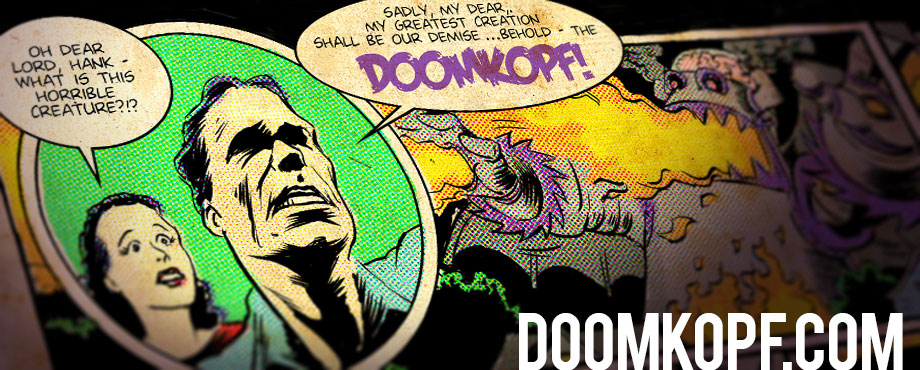The Doomino Effect for Aug 20, 2008
I’m going to pack two weeks of comics into this week’s Doomino Effect, but starting off is a new one from this week, Guardians of the Galaxy #4.

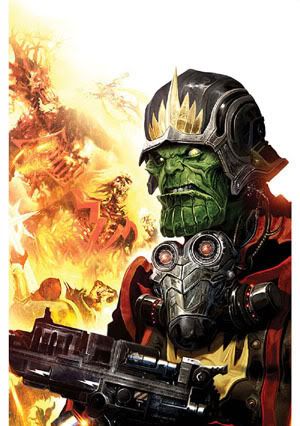 GotG has become one of my favorite series, even inspiring me to dig out my old ’90s Guardians of the Galaxy comics (and then quickly putting them back because they are crap and I only bought them because they were one of the few comics carried by my hometown drugstore) after the surprise return of Vance Astro.
GotG has become one of my favorite series, even inspiring me to dig out my old ’90s Guardians of the Galaxy comics (and then quickly putting them back because they are crap and I only bought them because they were one of the few comics carried by my hometown drugstore) after the surprise return of Vance Astro.
I love virtually everything about this series — the writing is fantastic, as Abnett and Lanning immediately pinned down the personalities and the interplay between a cast of characters I knew nothing about, following a crossover I didn’t read, and they even made me excited about the return of a character from a series that I just mentioned was not very good. On the art side, Paul Pelletier and Rick Magyar have created what is probably best described as a beautiful synthesis of the best of Alan Davis, Paul Neary and Mark Bagley with none of the worst.
That said, this is a Secret Invasion tie-in, and I wish this series would’ve been able to go for more than 3 issues before falling victim of a crossover. I didn’t read any of the Annihilation stuff, and I know that there was a Super Skrull in that, so injecting Skrull business into this series isn’t entirely out of left field. And I thought it was handled pretty well here — there was the obligatory paranoia for a page (which gets old, but I think really is necessary to keep the Skrull threat elevated to the level it needs to be) as well as the very quick and effective explanation of why these Skrulls should be a reason for concern (Drax saying “A Skrull’s bad enough; a Skrull that doesnt’ want you to know he’s a Skrull is a seriously bad deal”). I’m also kind of contradicting one of my main feelings about big crossovers, and that is that they need to be felt across the entire universe in order to get over how significant they are.
So I guess I’m not really feeling disappointment, as this did feel like a natural progression and not like it was thrust upon the series abruptly. I think maybe the bad taste in my mouth is just that the first three issues were so good that I’m suspicious of anything that has the potential to disrupt that flow — and I like Secret Invasion.

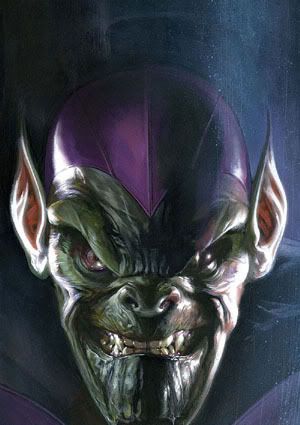 But speaking of Secret Invasion, that leads me to Secret Invasion #5. Doom DeLuise didn’t care for it, but I’m still really enjoying it. I’m also very much enjoying the series as a whole, particularly with the New Avengers and Mighty Avengers tie-ins. A few issues here and there have stunk (like SI #2, which was very little of anything, and the recent issue dedicated to Skrull Elektra, which was pointless) and the big series is a little too dependent on the side-stories taking place elsewhere for my taste, but overall I think I’m as pleased with this series as I hoped I would be.
But speaking of Secret Invasion, that leads me to Secret Invasion #5. Doom DeLuise didn’t care for it, but I’m still really enjoying it. I’m also very much enjoying the series as a whole, particularly with the New Avengers and Mighty Avengers tie-ins. A few issues here and there have stunk (like SI #2, which was very little of anything, and the recent issue dedicated to Skrull Elektra, which was pointless) and the big series is a little too dependent on the side-stories taking place elsewhere for my taste, but overall I think I’m as pleased with this series as I hoped I would be.
Reed Richards is back in the game, figuring out how the Skrulls have stayed hidden in order to mercifully draw the Savage Land chapter to a close. I can totally see how someone not enjoying the series as much as I have been getting very sick of the fact that we’re 5 issues in and still in the middle of all of that. I think this was as far as it could’ve gone without being ridiculous, so I’m glad it was tied up. The quick disposal of the remaining Skrulls was a nice way to show how the real heroes are pissed and bloodthirsty; it’s kind of got me wondering if there’s not going to be an ironic reversal as a result. The short emotional turn Hawkeye would’ve had to have gone through between believing his dead wife was back and then putting bullets in her is something I hope is revisited.
The “Who’s a Skrull?” conversation was mercifully short in this issue, and the characters themselves were aware of the “Not this again” aspect to it, which led to a quick escape from that particular nuisance. The elevation of Agent Brand and Maria Hill has been a long time coming, particularly with the latter, and the payoff was good. I’m also really liking the background stuff with Captain Marvel and Norman Osborne, but I really hope that’s not there just to spin off in another title.
The fact that the heroes are mobilized and ready to start fighting Skrulls with three issues left has me thinking there’s some big twist yet to come. Big Bendis Stories have been known to be anti-climactic, so I’m maybe hoping for it more than expecting it. Artwise, I can’t stop loving Yu.

 But speaking of big crossover stories, that leads me to Final Crisis: Revelations #1, Greg Rucka’s tale of The Spectre. I know little about the current incarnation of The Spectre and I care even less, and I was very pleased that this issue got me educated and caring.
But speaking of big crossover stories, that leads me to Final Crisis: Revelations #1, Greg Rucka’s tale of The Spectre. I know little about the current incarnation of The Spectre and I care even less, and I was very pleased that this issue got me educated and caring.
The Spectre is just dishing out vengeance (and not justice, as they are careful to point out), killing off villains like Dr. Light in a grotesque, cartoonish fashion (such as turning Dr. Light into a candle and then promptly extinguishing him) or burning Effigy. Then he sets his sights on Libra, who is not only unafraid of the Spectre, but able to defeat the Spectre. This had me hoping that this would set The Spectre on a quest to find a new host, which would end with Batman, but that wasn’t the case — instead the Spectre just regrouped and decided to go after The Question.
There was enough I wasn’t following and enough characters I wasn’t familiar with to where I’m not entirely sure what was going on. I’m not clear if Montoya is a killer and The Spectre has decided to punish her accordingly, or if Libra somehow got control of The Spectre or at least confused him enough to where he’s now taking out heroes. But the thing is, the things I don’t know managed to make me interested in following the story and seeing where it ends up. I wish I could say the same thing for the Big Event from which this Sub-Big Event takes its title.

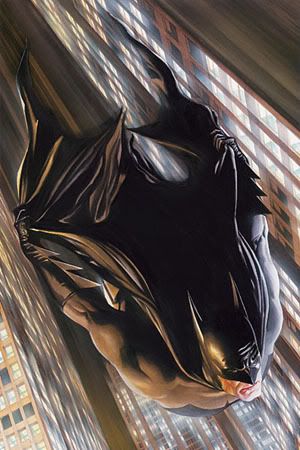 Speaking of Final Crisis, we’ll be reviewing Final Crisis: Legion of 3 Worlds #1 this weekend as our Book of Doom, but that leads me to Grant Morrison’s other big event, Batman R.I.P. in Batman #679. I’m enjoying Morrison’s work here a lot more than I am in Final Crisis. Dr. Hurt had apparently programmed in some hypnotic suggestion that turned off the Batman part of Bruce Wayne, for lack of a better term. But if I read this correctly, the ultimate anticipator was prepared for even something like that to happen, hence this crazy, hallucinating, brightly-colored Batman that’s on the rampage.
Speaking of Final Crisis, we’ll be reviewing Final Crisis: Legion of 3 Worlds #1 this weekend as our Book of Doom, but that leads me to Grant Morrison’s other big event, Batman R.I.P. in Batman #679. I’m enjoying Morrison’s work here a lot more than I am in Final Crisis. Dr. Hurt had apparently programmed in some hypnotic suggestion that turned off the Batman part of Bruce Wayne, for lack of a better term. But if I read this correctly, the ultimate anticipator was prepared for even something like that to happen, hence this crazy, hallucinating, brightly-colored Batman that’s on the rampage.
I really don’t care for Tony Daniel’s art. It’s often stiff and really lacking in the panel-to-panel storytelling at times. His style reminds me of someone Marvel would’ve brought onto the X-books in the early ’90s once all the Image guys left. But there are several things I really like about this series — one is that, like I mentioned with FC:Requiem above, the questions this series raises make me excited to read more, the opposite of what Final Crisis is doing. This thing isn’t contradicting things all over the place and requiring characters to do stupid and illogical things in order to heighten the tension and push the story. Secondly, I like that Morrison has involved what is essentially a new cast of villains and he’s making them seem (relatively) formidable (excusing Batman’s quick dressing-down of Charlie Caligula). I think these guys actually come from some ’50s comic books, which wouldn’t be surprising considering the writer, but as great as Batman’s list of villains is, it’s refreshing for a real threat to come from someone other than the usual suspects. That the Joker is going to be included in this gang only helps elevate the rest of them.

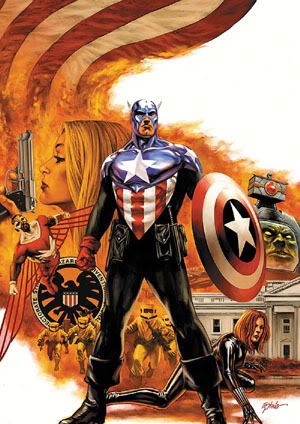 Speaking of title characters resting in peace, that leads me to Captain America #41. Dr. Faustus has turned on his evil buddies, allowing S.H.I.E.L.D. to find Sharon and setting up Senator Wright to get assassinated (I’m assuming he knew Sin would deviate from the plan and Wright would take the bullet, as Bucky new precisely where to put the shield). The new Captain America was able to save the day on national television, and now with one chapter left, he’s off presumably to stop the Red Skull and Krang as they figure out what to do with their own Captain America.
Speaking of title characters resting in peace, that leads me to Captain America #41. Dr. Faustus has turned on his evil buddies, allowing S.H.I.E.L.D. to find Sharon and setting up Senator Wright to get assassinated (I’m assuming he knew Sin would deviate from the plan and Wright would take the bullet, as Bucky new precisely where to put the shield). The new Captain America was able to save the day on national television, and now with one chapter left, he’s off presumably to stop the Red Skull and Krang as they figure out what to do with their own Captain America.
This series just really feels like what can happen when you have a great creative team that respects the material they’re working with and is allowed to tell a good story. They’re drawing on 1950s continuity without having to be even the slightest bit embarrassed about it and building onto something that will leave the series with a very well-established “now.” With every passing issue, I hope more and more that they keep Steve Rogers dead, or at the very least, don’t put him back in the title character role, because this exploration of Bucky as Captain America is great stuff.

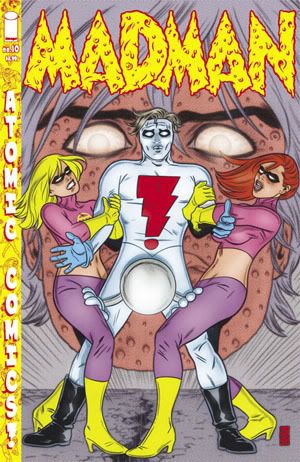 And speaking of exploring the title character, which is so unique that this was the only possible segue, that leads me to Madman Atomic Comics #10 in which Michael Allred continues to push the Madman storytelling in new directions … for better or worse.
And speaking of exploring the title character, which is so unique that this was the only possible segue, that leads me to Madman Atomic Comics #10 in which Michael Allred continues to push the Madman storytelling in new directions … for better or worse.
This is one of those series I’ve been buying out of loyalty, and several months now I’ve been telling myself “No more.” Frank Einstein knows more about his past, the Atomics are a much bigger part of the picture, the narration is often confusing and now Joe and It Girl are merged, though at least Frank is upset by that latter development. It really felt like Allred had just kind of gotten tired of his creation and was now just going to mess with it.
I almost didn’t even want to read this issue out of lack of anticipation, but Allred finally gave me the hope I was looking for that he really does have something great planned that’s true to the spirit of all the preceding works that made Madman fans like me loyal in the first place. The looming questions and problems were addressed and the story really felt like it was moving forward (after last month’s interesting-looking but ultimately frustrating issue that took place entirely in a single skirmish across five really long multi-page panels), and Allred gave enough reassurance in the letters page that I’m a lot less skeptical than I had been. He’s been taking some heat in letters he’s chosen to print (important point, in my opinion) but he’s continued to stress that he’s doing all of this experimental stuff for a good reason.
For several issues, I’ve thought to myself “Experimentation is nice, but when it makes bad comics, it makes bad comics.” Madman Atomic Comics #10 has officially ended my streak of half-heartedly swearing off this book.
